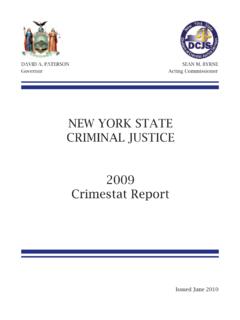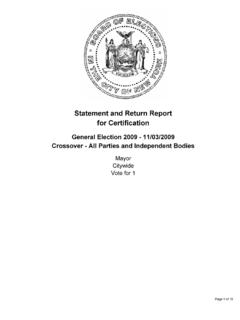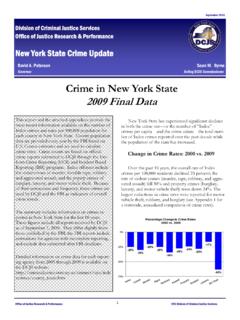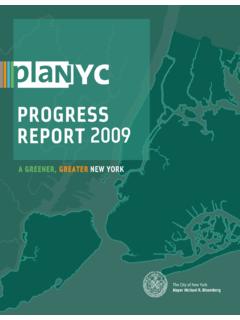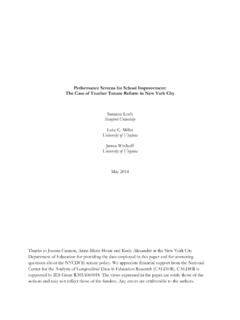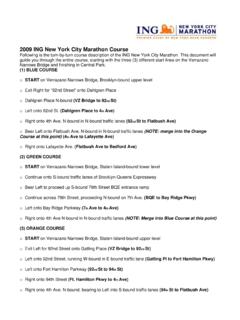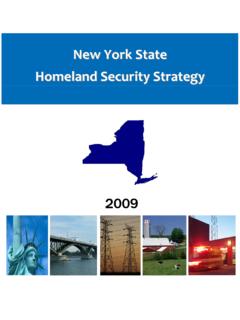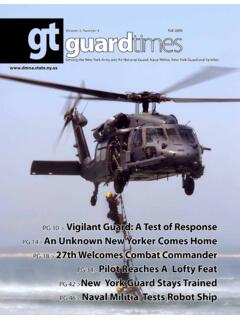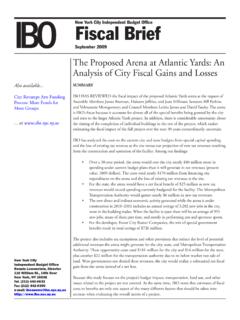Transcription of NEW YORK CITY AUDUBON’S HARBOR HERONS PROJECT: …
1 1 new york city AUDUBON S HARBOR HERONS PROJECT: 2009 INTERIM NESTING SURVEY 22 December 2009 Prepared for: new york city Audubon Glenn Phillips, Executive Director 71 W. 23rd Street, Suite 1529 new york , NY 10010 Tel. 212-691-7483 Prepared by: Elizabeth Craig NYC Audubon 71 W. 23rd Street, Suite 1529 new york , NY 10010 Tel. 212-691-7483 2 new york city Audubon s Conservation Programs are made possible by the leadership support of The Leon Levy Foundation and Mary and Joseph Fiore. Additional support for the HARBOR HERONS Nesting Surveys comes from the ConocoPhillips Bayway Refinery. This report should be cited as: Craig, E. 2009 . new york city Audubon s HARBOR HERONS Project: 2009 Interim Nesting Survey. new york city Audubon, new york , NY. 3 Abstract new york city Audubon s HARBOR HERONS Project Interim Nesting Survey of the new york HARBOR and surrounding waterways was conducted between 18 May and 1 June 2009 , with additional nesting observations later in June and July.
2 This report summarizes long-legged wading bird, cormorant, and gull nesting activity observed on selected islands, aids to navigation and at one mainland colony in 2009 . Species summaries: Nine species of long-legged wading birds nested on nine islands in NY HARBOR . These species, hereafter collectively referred to as waders, included Black-crowned Night-Heron, Great Egret, Snowy Egret, Glossy Ibis, Yellow-crowned Night-Heron, Little Blue Heron, Tricolored Heron, Cattle Egret, and Green Heron. Between the 2008 and 2009 interim surveys, population increases were observed for the Black-crowned Night-Heron, Yellow-crowned Night-Heron, Snowy Egret, and Glossy Ibis, and a population decrease was observed for the Great Egret. The Tricolored Heron, Little Blue Heron, Green Heron, and Cattle Egret continued to nest at low numbers.
3 Black-crowned Night- HERONS were typically the numerically dominant nesting species in mixed-species colonies. A total of 1,183 Double-crested Cormorant nests were observed, representing a decline from the 2008 total of 1,333 nests. As all potential colony sites in NY HARBOR were not surveyed in 2009 , system-wide species totals are not presented in tables. Gull and tern nest estimates were incomplete in 2009 , and should not be interpreted as declines. Island summaries: The largest species diversity was observed on Canarsie Pol (eight species). The greatest total number of nests was observed on Hoffman Island (542 nests), surpassing South Brother Island, which had been the largest wader colony in previous years, and continued to support a large portion of the wader community in 2009 (445 nests). No active wader nests were observed on the three islands in the Arthur Kill and Kill Van Kull.
4 Following an eight-year decline, this year marks the second consecutive year in which no waders were observed nesting on North Brother Island. Wader nesting activity on Huckleberry Island continued to persist at low levels. Mainland nesting of Yellow-crowned Night- HERONS was observed at the Redfern Houses colony in Far Rockaway, where 59 nests were observed. Double-crested Cormorants nested on seven islands, and cormorant nesting activity declined at all major nesting locations. 4 Additional cormorant nests were observed on aids to navigation in the Kill Van Kull, Arthur Kill and northwestern Raritan Bay. Herring and Great Black-backed gulls continued to nest throughout the HARBOR , although a total nest count was not conducted in 2009 . 5 Introduction new york city Audubon s (NYC Audubon) 2009 HARBOR HERONS interim nesting survey marks the 24th consecutive year of this project.
5 The primary objective of the surveys is to monitor the population status of wading birds ( HERONS , egrets, ibis) and cormorants on select islands in new york /New Jersey HARBOR and surrounding waterways, while also noting the presence of other nesting bird species and current nesting habitat. In Fall 2004, NYC Audubon made a decision to shift the HARBOR HERONS Nesting Survey from an annual to a triennial schedule (with the next complete survey scheduled for Spring 2010), and in intervening years to conduct interim surveys on islands where nesting occurred in the prior year. The US Army Corps of Engineers and The Port Authority of new york & New Jersey draft Comprehensive Restoration Plan for the Hudson-Raritan Estuary and the HARBOR HERONS Subcommittee of the HARBOR Estuary Program s draft HARBOR HERONS Conservation Plan are each slated for publication in 2010. Taken together, these two documents provide historical perspective of HARBOR HERONS and their breeding and foraging habitat, identify threats to the persistence of these species in the HARBOR , and lay out a plan of action for protecting these birds in the future.
6 This report summarizes nesting activity of long-legged wading birds, cormorants, and gulls observed on selected islands, aids to navigation and at one mainland colony documented during the 2009 field season, between 18 May and 1 June, with additional nesting observations later in June and July. The primary objectives of the 2009 interim survey were to: (1) monitor the population status of long-legged wading birds ( HERONS , egrets and ibis) cormorants, and gulls on selected islands; (2) document nesting habitat used by long-legged wading birds and cormorants; and (3) record the presence of other important nesting or migratory bird species. Monitoring long-term trends and short-term conditions in long-legged wading bird and cormorant nesting populations in NY HARBOR provides both an estimate of the relative health and stability of local colonial waterbird populations, and a valuable indicator of the overall health of the region s natural resources.
7 6 Methods The 2009 survey followed field methods designed for previous HARBOR HERONS Project nesting surveys [Katherine Parsons (1986-1995), Paul Kerlinger (1996-2004)] and the standard protocol of the new york State Department of Environmental Conservation s Long Island Colonial Waterbird and Piping Plover Survey (Litwin et al. 1993). All counts were conducted between 6:00AM and 4:00PM, and under clear conditions without rainfall, high winds (>8 knots), or temperatures above 80 F. Most counts were conducted once from 18-30 May; additional observations were made between early June and July (see Table 1 for dates). Islands surveyed in 2009 (Table 1, Figure 1) included three in the Arthur Kill-Kill Van Kull complex (Shooter s and Prall s islands, and Isle of Meadows); two in Lower new york HARBOR (Hoffman and Swinburne islands); four in the East River/Western Long Island Sound area (U Thant, Mill Rock, and North and South Brother islands); and two in the Hutchinson River/Long Island Sound area (Goose and Huckleberry islands).
8 Partial colonial waterbird estimates were conducted at three islands in Jamaica Bay: Canarsie Pol, Elders Point West, and Subway Island. Additionally, observations of (1) Double-crested Cormorant nests on aids to navigation ( , channel markers and beacons) in the Kill Van Kull, Arthur Kill and northwestern Raritan Bay and (2) Yellow-crowned Night-Heron nesting at a mainland colony are also presented below. These islands were surveyed by a research team consisting of the author, volunteers from NYC Audubon and other organizations, and staff from new york city Department of Parks and Recreation (NYCDPR) and the National Park Service (NPS). Double-crested Cormorant counts were conducted by the author with Susan Elbin and numerous volunteers as part of an ongoing study of cormorant population dynamics, habitat use, and foraging ecology in NY/NJ HARBOR .
9 Surveys at Goose and Huckleberry islands were conducted jointly with David K nstler (NYCDPR, Van Cortlandt & Pelham Bay Parks Administrators Office). Surveys of islands in the Arthur Kill and Kill Van Kull were conducted by Alexander Summers (NYCDPR). Don Riepe of the American Littoral Society/Jamaica Bay Guardian provided information on colonial waterbird activity in Jamaica Bay. Surveys were conducted by one or two teams of researchers lead by the author and trained volunteers. Groups quickly and systematically searched for nests on each island, initially focusing effort on areas occupied by nesting birds in previous years. Depending on the colony size, each team was composed of two counters ( one person using a telescopic mirror pole to examine contents of nests up to five meters from the ground, and another to record data), and from one to three spotters, who moved slightly ahead to direct the counters to nests and keep multiple teams from re-sampling the same nests.
10 A nest was deemed active if it contained eggs or young, if there was evidence of recent construction ( fresh twigs or vegetation in nest) or use ( a layer of fresh feces underneath a nest), or by direct observation of adults on or within one meter of a nest with the above characteristics. Whenever possible, nests were identified to species by the presence of young, eggs and clearly discernable nest structure. Nests beyond the reach of the mirror pole were examined with binoculars. If nest contents could still not be confirmed, but other evidence suggested recent activity ( feces, new nest construction), nesting species was noted as unknown . Old or unused nests were noted in the count as empty , but not included in the final tally of active nests. Nesting vegetation ( , tree, shrub, or 7 vine species) was recorded for all species whenever possible by observers skilled in plant identification.

